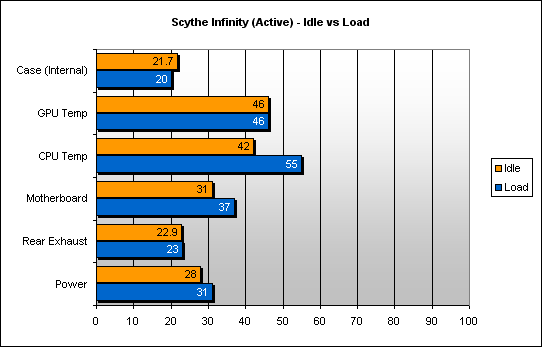--- Thermal Performance, Conclusion and Certification
Thermal Performance
Much like the Cooler Master GemenII, we carried out two thermal runs with the Scythe Infinity. First was an actively-cooled configuration with one 120mm fan attached, followed by passive with no fan.Although the GemenII carried dual 120mm fans, its depth was very different to the Infinity. While the GemenII has fins only up top, the Infinity carries them almost from top to bottom. Anyway, let's see how each Scythe configuration fared, starting with actively-cooled.
Thermal Performance - Active

At idle, the Infinity started showing us why it has become so popular with the enthusiast market. CPU temperature was 42 degrees, earning an enviable joint 3rd place out of 27 configurations.
In other temperature areas, there was very little to separate the Infinity from those sharing 3rd place. It did beat others in some areas but, taken over the five idle readings, things levelled out for all those in 3rd.
Under load, though, the Infinity dropped down a few places to 6th with a CPU reading of 55 degree. The only other reading of note was the internal case temperature of 20 degrees – the Infinity actually lowered the internal case temperature as the motherboard-controlled fans properly kicked into life.
Thermal Performance - Passive
Before carrying out the passive tests, the entire cooler was removed, left for a few hours and refitted using fresh thermal paste. That way, we not only carried out a fully-timed fitting test but also ensured there was no bias from the previously run benchmarks.Even in passive configuration, the Infinity impressed. It shared joint 12th place at idle, leaving ten actively-cooled products in its wake! Okay, the same 45 degree CPU reading was shared with five other coolers at idle but all of them were active – the nearest passively-cooled competitor was seven places lower down.

Under load, the passively-cooled Infinity started to suffer a bit, dropping to joint 18th with a reading of 63 degrees. Even so, it managed to beat a number of actively-cooled rivals and sat six places higher than the next passive cooler.
Conclusion
The size of the cooler caused us some fitting problems, even with its push-pin mounting system. But what a performance during the thermal tests! Especially the passive configuration, which wiped the floor with its direct competitors.Results for the actively-cooled set up were also very respectable and the two sets together emphasise just how versatile the Infinity is. However, sheer size, even without fans, means that the Infinity's passive-running advantages won't be available in the small cases of home theatre PC (HTPC) cases where quiet-running is so very necessary.
Based on the results we saw, Scythe's success with the Infinity is richly deserved. We do, though, have one little complaint – about the fan springs. We think that Scythe should include two lots and not expect buyers to have to pay out for an additional accessories set to get a second.
Certification

Scythe Infinity









